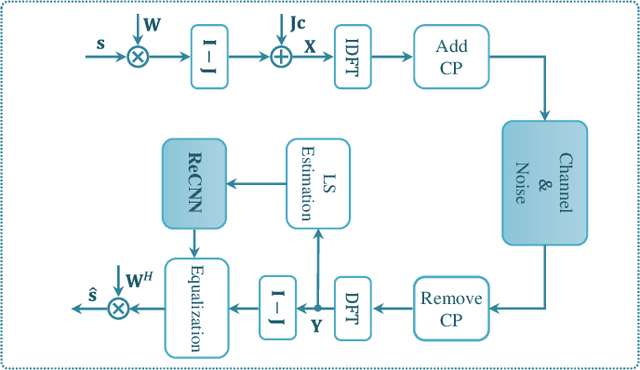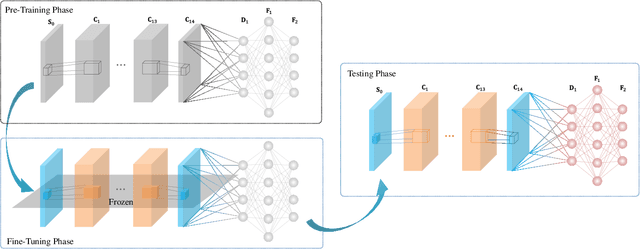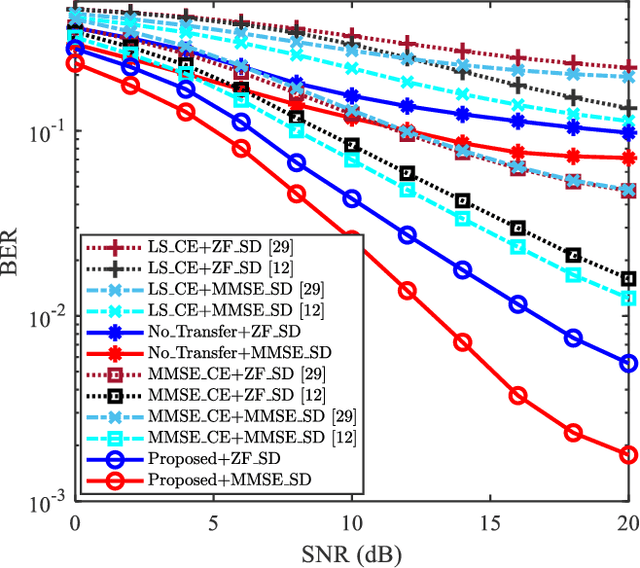Guowei Ling
Superimposed Pilot-based Channel Estimation for RIS-Assisted IoT Systems Using Lightweight Networks
Dec 07, 2022Abstract:Conventional channel estimation (CE) for Internet of Things (IoT) systems encounters challenges such as low spectral efficiency, high energy consumption, and blocked propagation paths. Although superimposed pilot-based CE schemes and the reconfigurable intelligent surface (RIS) could partially tackle these challenges, limited researches have been done for a systematic solution. In this paper, a superimposed pilot-based CE with the reconfigurable intelligent surface (RIS)-assisted mode is proposed and further enhanced the performance by networks. Specifically, at the user equipment (UE), the pilot for CE is superimposed on the uplink user data to improve the spectral efficiency and energy consumption for IoT systems, and two lightweight networks at the base station (BS) alleviate the computational complexity and processing delay for the CE and symbol detection (SD). These dedicated networks are developed in a cooperation manner. That is, the conventional methods are employed to perform initial feature extraction, and the developed neural networks (NNs) are oriented to learn along with the extracted features. With the assistance of the extracted initial feature, the number of training data for network training is reduced. Simulation results show that, the computational complexity and processing delay are decreased without sacrificing the accuracy of CE and SD, and the normalized mean square error (NMSE) and bit error rate (BER) performance at the BS are improved against the parameter variance.
Transfer Learning-based Channel Estimation in Orthogonal Frequency Division Multiplexing Systems Using Data-nulling Superimposed Pilots
May 28, 2022



Abstract:Data-nulling superimposed pilot (DNSP) effectively alleviates the superimposed interference of superimposed training (ST)-based channel estimation (CE) in orthogonal frequency division multiplexing (OFDM) systems, while facing the challenges of the estimation accuracy and computational complexity. By developing the promising solutions of deep learning (DL) in the physical layer of wireless communication, we fuse the DNSP and DL to tackle these challenges in this paper. Nevertheless, due to the changes of wireless scenarios, the model mismatch of DL leads to the performance degradation of CE, and thus faces the issue of network retraining. To address this issue, a lightweight transfer learning (TL) network is further proposed for the DL-based DNSP scheme, and thus structures a TL-based CE in OFDM systems. Specifically, based on the linear receiver, the least squares estimation is first employed to extract the initial features of CE. With the extracted features, we develop a convolutional neural network (CNN) to fuse the solutions of DLbased CE and the CE of DNSP. Finally, a lightweight TL network is constructed to address the model mismatch. To this end, a novel CE network for the DNSP scheme in OFDM systems is structured, which improves its estimation accuracy and alleviates the model mismatch. The experimental results show that in all signal-to-noise-ratio (SNR) regions, the proposed method achieves lower normalized mean squared error (NMSE) than the existing DNSP schemes with minimum mean square error (MMSE)-based CE. For example, when the SNR is 0 decibel (dB), the proposed scheme achieves similar NMSE as that of the MMSE-based CE scheme at 20 dB, thereby significantly improving the estimation accuracy of CE. In addition, relative to the existing schemes, the improvement of the proposed scheme presents its robustness against the impacts of parameter variations.
 Add to Chrome
Add to Chrome Add to Firefox
Add to Firefox Add to Edge
Add to Edge